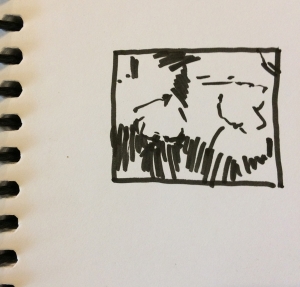The pursuit of light and dark shapes, of simplifying our perceptions, this is truly the work of an artist. And it hearkens back to our first moments of life.
When I am in my studio, I love to listen to podcasts, and Invisibilia is a new favorite. The other day, their piece on emotions, and how they are constructed through experience tipped me off to looking at my art in a new way. The neuroscientist, Dr. Lisa Feldman Barrett was describing how we have basic inner feelings (pleasant, unpleasant, arousal, calm), but that our culture/family/personal experience constructs much more dynamic and complicated emotions.
Dr. Barrett made an brief analogy about how when people first have vision, late in life, they can only see light and dark. The patterns of light and dark do not create three-dimensional objects until we have had enough experience in the world to learn these concepts of objects, colors, etc.
This is when it hit me like a thunderbolt.
As painters, we are constantly trying to simplify the scene into light and dark shapes. We try to let go of our preconceived notions of what a tree looks like, what a hand looks like. Instead, we try to take things as they are and recreate them on a two-dimensional surface. In essence, we are constantly striving to get back to that primal experience in vision. The one babies, or the newly-sighted, see. Just a bundle of light and dark shapes. The closer we can get to this genesis of sight, the more successful our art becomes.
If you are interested in learning more about learning how to see, and what role our experiences play in our visual experience, check out this article:
http://www.newyorker.com/tech/elements/people-cured-blindness-see
The day after I heard this concept articulated, I went on a wildflower mission. It is a little early to see wildflowers, and that’s why it felt like a mission. I found myself in some non-descript bushes on the side of the Sanctuary trail in Steamboat Springs. There, nestled in the leaves, was the early blossom of a sticky geranium.
Perhaps it was the effect of the podcast, or perhaps it was the “weedy” environs (no epic snow-topped mountain backdrop), but I really focused on the light and dark. I started with a Notan sketch, using only white and black.
Then, with the plein air study, I continued to simplify my vision, using squinting and stepping back from my canvas. I always say that it is good that painting is a life-long career, because it will take even more than that to master it. And now, I understand, sometimes there is un-learning in the learning process!




